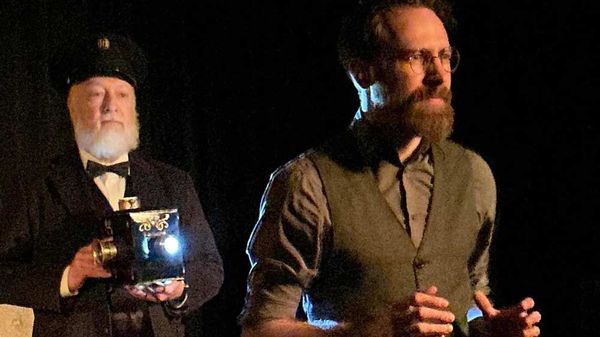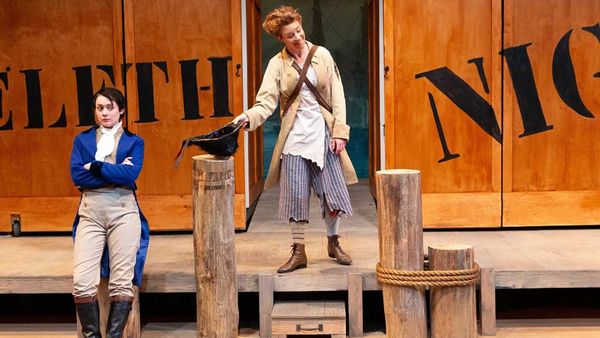November 7, 2010
La Bayadere
Sue Katz READ TIME: 3 MIN.
The Boston Ballet has taken a fearless approach to the 1877 Russian classic La Bayadere, originally choreographed by the legendary Marius Petipa to music by his frequent collaborator Ludwig Minkus. It is amply supported by the Boston Ballet Orchestra, which exceeded its usual high standards, not the least the first violinist whose splendid and delicate tone underpinned the score's emotional content.
First to the narrative: Because it is set in a mythical ancient India, the ballet's pageantry combines fairy-tale iconic notions of a past India with the drama of a classic love triangle. At the Temple celebration of the "Ritual of Fire" in Act I, Nikiya, the most beautiful of the bayaderes - the temple dancers - falls for the handsome Solor, to the annoyance of the High Brahmin, who wanted her for himself.
However, back at the secular palace, the Rajah is so impressed with Solor that he decides to bestow on the young man his precious daughter Gamzatti. Haughty as the princess is, she is so vulnerable to Solor's charms that she falls in love with his portrait before they even meet. Solor - a bit of a rogue - is smitten by Gamzatti's beauty and agrees to the match, betraying in the process the pure love to Nikiya.
By Act II, the jealous High Brahmin's plan to get Solor in trouble by telling the Rajah about his connection to Nikiya backfires. Nikiya is forced to dance at the engagement party of her lover and her rival, while plotters hide a poisonous snake in her flowers and, rather than take an antidote, she goes for tragic death.
Act III is full of grief and opium, leading to a classic ethereal scene of lovers being reunited in the hazy Kingdom of Shades.
The settings and the costumes, full of intricate if delicate filigreed design based on the original 19th Century production, are as crucial to the ballet as the dancing. From the main stage curtain with its giant elephant image to the courtyard of the Temple and on to the sumptuous palace interior, the eye-candy design elicited gasps each time the curtain was raised. The costumes were scanty and form-fitting, color coordinated to the mood and setting of the scene.
Three Boston Ballet principal dancers took the leading roles. Dancing the part of Nikiya, Misa Kuranaga proved a tireless sliver of grace and emotion the night of this review, Friday, November 5th. As the aristocratic Gamzatti, Erica Cornejo maintained the pomposity and strength called for by her character. Unfortunately, James Whiteside - the man in the middle - while strong in his solo work, seemed slightly detached when working with the women. His disengagement stole from what should have been touching romance, forcing the two women to try to convey all the passion.
The betrothal celebration in Act II opens with a circus-like series of entries: the groom rides into the elaborate hall on an elephant; the Rajah is carried in on a chair by soldiers; the Golden Idol is lifted high on a platform as the crowd mingles and parties. The entertainment shifts among them - from the feather-masked warriors dancing to strong drums to a girl balancing a gourd on her head as she dances between two friends. But it is the Golden Idol, performed by Jeffrey Cirio to the biggest applause of the night, who transfixes. He dances the part with stunning precision, spinning and speeding across the stage, his gilded body providing a faultless sense of ancient religious secrets.
When the future bride and groom get together, there are a few moments of faulty synchronization until they smooth out their pas de deux. The dramatic high, though, belongs to Nikiya, forced to dance for her rival and her betrayer and finally choosing death in her despair.
It is, however, in the famed Act III that La Bayadere justifies its longevity in the classic canon. Bummed out in his tent after the gala, Solor smokes some opium and falls into a suspended state. Minkus's haunting musical theme accompanies a mesmerizing procession of the Shades, who descend winding ramps from the realm of the spirits down to this world. Danced by 24 ballerinas in white tutus, one after the next comes into view following her successors in an exquisite march of perfect unison. The harmony and the repetition of their leg lifts and back bends are hypnotic, almost literally, and the corps de ballet received a massive final ovation from the appreciative audience.
Throughout, the almost tearful violin, the lavish sets and the luminous corps combine to support the talented dancers in bringing this world premiere production to Boston. Special kudos to conductor Jonathan McPhee and to the memorable choreography (after Marius Petipa) of Florence Clerc.
Sue Katz is a "wordsmith and rebel" who has been widely published on the three continents where she has lived. She used to be proudest of her 20-year martial arts career, her world travel, and her edgy blog Consenting Adult (suekatz.typepad.com), but now she's all about her collection of short stories about the love lives of older people, Lillian's Last Affair.







